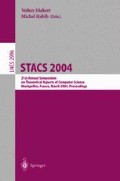Abstract
An automatic structure \(\mathcal{A}\) is one whose domain A and atomic relations are finite automaton (FA) recognisable. A structure isomorphic to \(\mathcal{A}\) is called automatically presentable. Suppose R is an FA recognisable relation on A. This paper concerns questions of the following type. For which automatic presentations of \(\mathcal{A}\) is (the image of) R also FA recognisable? To this end we say that a relation R is intrinsically regular in a structure \(\mathcal{A}\) if it is FA recognisable in every automatic presentation of the structure. For example, in every automatic structure all relations definable in first order logic are intrinsically regular. We characterise the intrinsically regular relations of some automatic fragments of arithmetic in the first order logic extended with quantifiers ∃ ∞ interpreted as ‘there exists infinitely many’, and ∃ (i) interpreted as ‘there exists a multiple of i many’.
Access this chapter
Tax calculation will be finalised at checkout
Purchases are for personal use only
Preview
Unable to display preview. Download preview PDF.
References
Ash, C.J., Nerode, A.: Intrinsically recursive relations. In: Aspects of effective algebra, Clayton, pp. 26–41 (1979); Upside Down A Book Co. Yarra Glen (1981)
Bruyère, V., Hansel, G., Michaux, C., Villemaire, R.: Logic and p-recognizable sets of integers. Bull. Belg. Math. Soc. 1, 191–238 (1994)
Blumensath, A., Grädel, E.: Automatic Structures. In: Proceedings of 15th Symposium on Logic in Computer Science, LICS 2000 (2000)
Enderton, H.B.: A mathematical introduction to logic, 1st edn. Academic Press, London (1972)
Ershov, et al. (eds.): Handbook of Recursive Mathematics. Studies in Logic and the foundations of Mathematics, vol. 1. Elsevier, Amsterdam (1998)
Khoussainov, B., Nerode, A.: Automatic presentations of structures. In: Leivant, D. (ed.) LCC 1994. LNCS, vol. 960, pp. 367–392. Springer, Heidelberg (1995)
Author information
Authors and Affiliations
Editor information
Editors and Affiliations
Rights and permissions
Copyright information
© 2004 Springer-Verlag Berlin Heidelberg
About this paper
Cite this paper
Khoussainov, B., Rubin, S., Stephan, F. (2004). Definability and Regularity in Automatic Structures. In: Diekert, V., Habib, M. (eds) STACS 2004. STACS 2004. Lecture Notes in Computer Science, vol 2996. Springer, Berlin, Heidelberg. https://doi.org/10.1007/978-3-540-24749-4_39
Download citation
DOI: https://doi.org/10.1007/978-3-540-24749-4_39
Publisher Name: Springer, Berlin, Heidelberg
Print ISBN: 978-3-540-21236-2
Online ISBN: 978-3-540-24749-4
eBook Packages: Springer Book Archive

